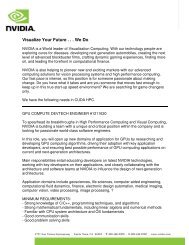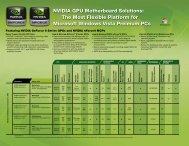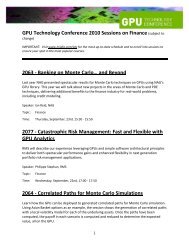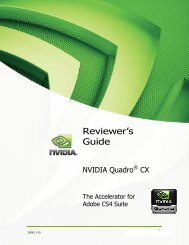Opencl Optimization
Opencl Optimization
Opencl Optimization
Create successful ePaper yourself
Turn your PDF publications into a flip-book with our unique Google optimized e-Paper software.
OpenCL <strong>Optimization</strong><br />
San Jose | 10/2/2009 | Peng Wang, NVIDIA
Outline<br />
• Overview<br />
• The CUDA architecture<br />
• Memory optimization<br />
• Execution configuration optimization<br />
• Instruction optimization<br />
• Summary
Overall <strong>Optimization</strong> Strategies<br />
• Maximize parallel execution<br />
– Exposing data parallelism in algorithms<br />
– Choosing execution configuration<br />
– Overlap memory transfer with computation<br />
• Maximize memory bandwidth<br />
– Avoid starving the GPU<br />
• Maximize instruction throughput<br />
– Get the job done with as few clock cycles as possible<br />
• Profiling your code before doing optimization<br />
– NVIDIA OpenCL visual profiler<br />
We will talk about how to do those in NVIDIA GPUs.<br />
Very similar to CUDA C.
Outline<br />
• Overview<br />
• The CUDA architecture<br />
• Memory optimization<br />
• Execution configuration optimization<br />
• Instruction optimization<br />
• Summary
Tesla Compute Architecture (GT200)<br />
• GPU contains 30 Streaming Multiprocessors (SM)<br />
• Each Multiprocessor contains<br />
– 8 Scalar Processors (SP)<br />
• IEEE 754 32-bit floating point<br />
• 32-bit and 64-bit integer<br />
– 1 Multithreaded Instruction Unit<br />
• Up to 1024 concurrent threads<br />
– 1 Double Precision Unit: IEEE 754 64-bit floating point<br />
– 2 Special Function Units (SFU)<br />
– 16 KB shared memory<br />
– 16K 32-bit registers<br />
I-Cache<br />
MT Issue<br />
C-Cache<br />
SP SP<br />
SP SP<br />
SP SP<br />
DP<br />
Geometry Controller<br />
SMC<br />
SFU SFU SFU SFU SFU SFU<br />
Shared<br />
Memory<br />
TPC<br />
I-Cache<br />
MT Issue<br />
C-Cache<br />
SP SP<br />
SP SP SP SP SP SP<br />
SP SP<br />
SP SP<br />
DP<br />
Shared<br />
Memory<br />
Texture Unit<br />
Tex L1<br />
I-Cache<br />
MT Issue<br />
C-Cache<br />
SP SP<br />
SP SP<br />
SP SP<br />
DP<br />
Shared<br />
Memory<br />
SP<br />
SM<br />
I-Cache<br />
MT Issue<br />
C-Cache<br />
SP SP<br />
DP<br />
SP<br />
SP SP<br />
SP SP<br />
SFU SFU<br />
Shared<br />
Memory
Fermi Compute Architecture<br />
• 16 Multiprocessors<br />
• Each Multiprocessor contains:<br />
– 32 Cores<br />
• 32 FP32 ops/clock<br />
• 16 FP54 ops/clock<br />
– 2 Warp Scheduler<br />
• Up to 1536 threads concurrently<br />
– Up to 48 KB shared memory<br />
– Up to 48 KB L1 cache<br />
– 4 SFUs<br />
Load/Store Units x 16<br />
64K Configurable<br />
Cache / Shared Mem<br />
– 32K 32-bit registers Uniform Cache<br />
Core<br />
Instruction Cache<br />
Scheduler Scheduler<br />
Dispatch Dispatch<br />
Register File<br />
Core Core Core<br />
Core Core Core Core<br />
Core Core Core Core<br />
Core Core Core Core<br />
Core Core Core Core<br />
Core Core Core Core<br />
Core Core Core Core<br />
Core Core Core Core<br />
Special Func Units x 4<br />
Interconnect Network
Execution Model<br />
OpenCL GPU<br />
Work-item/thread<br />
Work-group<br />
...<br />
Scalar<br />
Processor<br />
Multiprocessor<br />
Grid Device<br />
Work-item are executed by scalar processors<br />
Work-groups are executed on multiprocessors<br />
Work-groups do not migrate<br />
Several concurrent work-groups can reside on<br />
one SM- limited by SM resources<br />
A kernel is launched as a grid of work-groups<br />
In GT200, only one kernel can execute on a<br />
device at one time (Up to 16 in Fermi)
Warp and SIMT<br />
time<br />
SM multithreaded<br />
Warp scheduler<br />
warp 8 instruction 11<br />
warp 1 instruction 42<br />
warp 3 instruction 95<br />
.<br />
warp 8 instruction 12<br />
warp 3 instruction 96<br />
...<br />
Work-group<br />
=<br />
32 Threads<br />
32 Threads<br />
32 Threads<br />
Warps<br />
• Work-groups divided into groups of 32 threads<br />
called warps.<br />
• Warps always perform same instruction (SIMT)<br />
• Warps are basic scheduling units (Fermi schedules<br />
2 warps at the same time)<br />
• 4 clock cycles to dispatch an instruction to<br />
all the threads in a warp (2 in Fermi)<br />
• A lot of warps can hide memory latency
OpenCL Memory Hierarchy<br />
Private<br />
Memory<br />
Private<br />
Memory<br />
Work Item 1 Work Item M Work Item 1 Work Item M<br />
PE PE PE PE<br />
Compute Unit 1<br />
Private<br />
Memory<br />
Private<br />
Memory<br />
Compute Unit N<br />
Local Memory Local Memory<br />
Compute Device<br />
Global / Constant Memory Data Cache<br />
Global Memory<br />
Compute Device Memory<br />
• Global: R/W per-kernel<br />
• Constant : R per-kernel<br />
• Local memory: R/W per-group<br />
• Private: R/W per-thread
Mapping OpenCL to the CUDA<br />
Architecture<br />
Private<br />
Memory<br />
Private<br />
Memory<br />
Work Item 1 Work Item M Work Item 1 Work Item M<br />
PE PE PE PE<br />
Compute Unit 1<br />
Private<br />
Memory<br />
Private<br />
Memory<br />
Compute Unit N<br />
Local Memory Local Memory<br />
Compute Device<br />
Global / Constant Memory Data Cache<br />
Global Memory<br />
Compute Device Memory<br />
OpenCL CUDA Architecture<br />
Registers Registers<br />
Thread<br />
Processor<br />
Thread<br />
Processor<br />
Multiprocessor<br />
Registers Registers<br />
Thread<br />
Processor<br />
Thread<br />
Processor<br />
Multiprocessor<br />
Shared Memory Shared Memory<br />
Compute Device<br />
Global / Constant Memory Data Cache<br />
Global/Local Memory<br />
Compute Device Memory
Outline<br />
• Overview<br />
• The CUDA architecture<br />
• Memory optimization<br />
• Execution configuration optimization<br />
• Instruction optimization<br />
• Summary
Overview of Memory <strong>Optimization</strong><br />
• Minimize hostdevice data transfer<br />
• Coalesce global memory access<br />
• Use local memory as a cache
Minimizing host-device data transfer<br />
• Hostdevice data transfer has much lower bandwidth<br />
than global memory access.<br />
– 8 GB/s (PCI-e, x16 Gen2) vs 141 GB/s (GTX 280)<br />
• Minimize transfer<br />
– Intermediate data can be allocated, operated, de-allocated directly on GPU<br />
– Sometimes it’s even better to recompute on GPU<br />
– Move CPU codes to GPU that do not have performance gains if it can reduce data transfer<br />
• Group transfer<br />
– One large transfer much better than many small ones: latency ~ 10 microsec, thus for data<br />
size < 4KB, transfer time is dominated by latency
Coalescing<br />
• Global memory latency: 400-800 cycles.<br />
The single most important performance consideration!<br />
• Global memory access by threads of a half warp (16) can be<br />
coalesced to one transaction for word of size 8-bit, 16-bit, 32bit,<br />
64-bit or two transactions for 128-bit. (On Fermi, coalescing<br />
is for warp)
Compute Capability<br />
• First generation CUDA architecture (G80) has compute capability<br />
1.0, 1.1, e.g. GTX 8800, Tesla 870,<br />
• Second generation CUDA architecture (GT200) has compute<br />
capability 1.3, e.g. GTX 280, Tesla C1060<br />
• A full list of compute capability of various cards can be found at<br />
appendix A.1 of the OpenCL programming guide<br />
• Target compute capability 1.0 with optional optimizations for<br />
higher compute capabilities (unless you know exactly the GPU<br />
your kernels will run on)
Segments<br />
• Global memory can be viewed as composing aligned segments of<br />
16 and 32 words.<br />
E.g. 32-bit word:
Coalescing in Compute Capability 1.0<br />
and 1.1<br />
• K-th thread in a half warp must access the k-th word in<br />
a segment; however, not all threads need to participate<br />
…<br />
…<br />
…<br />
Coalesces – 1 transaction<br />
Out of sequence – 16 transactions<br />
Misaligned – 16 transactions<br />
…<br />
…<br />
…
Coalescing in Compute Capability<br />
>= 1.2<br />
• Coalescing for any pattern of access that fits into a segment size<br />
• # of transactions = # of accessed segments
Coalescing in Compute Capability<br />
>= 1.2<br />
1 transaction - 64B segment<br />
2 transactions - 64B and 32B segments<br />
1 transaction - 128B segment
Example of Misaligned Accesses<br />
__kernel void offsetCopy(__global float *odata,<br />
__global float* idata,<br />
int offset)<br />
{<br />
int xid = get_global_id(0) + offset;<br />
odata[xid] = idata[xid];<br />
}<br />
offset=1<br />
GTX280 (compute capability 1.3) drops<br />
by a factor of 1.7 while GTX 8800 (compute<br />
capability 1.0) drops by a factor of 8.
Example of Strided Accesses<br />
__kernel void strideCopy(__global float* odata,<br />
__global float* idata,<br />
int stride)<br />
{<br />
int xid = get_global_id(0) * stride;<br />
odata[xid] = idata[xid];<br />
}<br />
stride=2<br />
Large strides often arise in<br />
applications. However, strides<br />
can be avoided using local memory.<br />
Graceful scaling in GTX280
Local Memory<br />
• Latency ~100x smaller than global memory<br />
• Threads can cooperate through local memory<br />
• Cache data to reduce global memory access<br />
• Use local memory to avoid non-coalesced global<br />
memory access
Caching Example:<br />
Matrix Multiplication<br />
Every thread corresponds to one entry in C.<br />
C=AxB<br />
__kernel void simpleMultiply(__global float* a,<br />
__global float* b,<br />
__global float* c,<br />
int N)<br />
{<br />
int row = get_global_id(1);<br />
int col = get_global_id(0);<br />
float sum = 0.0f;<br />
for (int i = 0; i < TILE_DIM; i++) {<br />
sum += a[row*TILE_DIM+i] * b[i*N+col];<br />
}<br />
c[row*N+col] = sum;<br />
}
Memory Access Pattern of a Half-Warp<br />
Each iteration, threads access the same element in A.<br />
Un-coalesced in CC
Matrix Multiplication (cont.)<br />
<strong>Optimization</strong> NVIDIA GeForce<br />
GTX 280<br />
No optimization<br />
NVIDIA GeForce<br />
GTX 8800<br />
8.8 GBps 0.7 GBps<br />
Coalesced using local<br />
memory to store a tile<br />
of A 14.3 GBps 8.2 GBps<br />
Using local memory to<br />
eliminate redundant<br />
reads of a tile of B<br />
29.7 GBps 15.7 GBps
Matrix Multiplication (cont.)<br />
__kernel void coalescedMultiply(__global float* a,<br />
__global float* b,<br />
__global float* c,<br />
int N,<br />
__local float aTile[TILE_DIM][TILE_DIM])<br />
{<br />
int row = get_global_id(1);<br />
int col = get_global_id(0);<br />
float sum = 0.0f;<br />
int x = get_local_id(0);<br />
int y = get_local_id(1);<br />
aTile[y][x] = a[row*TILE_DIM+x];<br />
for (int i = 0; i < TILE_DIM; i++) {<br />
sum += aTile[y][i]* b[i*N+col];<br />
}<br />
c[row*N+col] = sum;<br />
}
Matrix Multiplication (cont.)<br />
<strong>Optimization</strong> NVIDIA GeForce<br />
GTX 280<br />
No optimization<br />
NVIDIA GeForce<br />
GTX 8800<br />
8.8 GBps 0.7 GBps<br />
Coalesced using local<br />
memory to store a tile<br />
of A 14.3 GBps 8.2 GBps<br />
Using local memory to<br />
eliminate redundant<br />
reads of a tile of B<br />
29.7 GBps 15.7 GBps
Coalescing Example:<br />
Matrix Transpose<br />
A<br />
A B<br />
tile<br />
B<br />
Strided global mem access in<br />
naïve implementation, resulting<br />
in 16 transactions if stride > 16<br />
Move the strided access into<br />
local memory read
Matrix Transpose Performance<br />
<strong>Optimization</strong> NVIDIA GeForce<br />
GTX 280<br />
No optimization<br />
Using local memory to<br />
coalesce global reads<br />
NVIDIA GeForce<br />
GTX 8800<br />
1.1 GBps 0.5 GBps<br />
24.8 GBps 13.2 GBps<br />
Removing bank<br />
conflicts 30.3 GBps 15.6 GBps
Bank Conflicts<br />
• A 2 nd order effect<br />
• Local memory is divide into banks.<br />
– Successive 32-bit words assigned to<br />
successive banks<br />
– Number of banks = 16 for CC 1.x (32 in Fermi)<br />
• R/W different banks can be performed<br />
simultaneously.<br />
• Bank conflict: two R/W fall in the same<br />
bank, the access will be serialized.<br />
• Thus, accessing should be designed to<br />
avoid bank conflict<br />
Local memory<br />
Bank 0<br />
Bank 1<br />
Bank 2<br />
Bank 3<br />
Bank 4<br />
Bank 5<br />
Bank 6<br />
Bank 7<br />
Bank 15
Outline<br />
• Overview<br />
• The CUDA architecture<br />
• Memory optimization<br />
• Execution configuration optimization<br />
• Instruction optimization<br />
• Summary
Work-group Heuristics for Single<br />
Kernel<br />
• # of work-groups > # of SM<br />
– Each SM has at least one work-group to execute<br />
• # of work-groups / # of SM > 2<br />
– Multi work-groups can run concurrently on a SM<br />
– Work on another work-group if one work-group is waiting on barrier<br />
• # of work-groups / # of SM > 100 to scale well to<br />
future device
Work-item Heuristics<br />
• The number of work-items per work-group should be a<br />
multiple of 32 (warp size)<br />
• Want as many warps running as possible to hide latencies<br />
• Minimum: 64<br />
• Larger, e.g. 256 may be better<br />
• Depends on the problem, do experiments!
Occupancy<br />
• Hide latency: thread instructions are issued sequentially.<br />
So executing other warps when one warp is paused is the<br />
only way to hide latencies and keep the hardware busy<br />
• Occupancy: ratio of active warps per SM to the maximum<br />
number of allowed warps<br />
– Maximum allowed warps: 32 in Tesla (48 in Fermi).
Latency Hiding Calculation<br />
• Arithmetic instruction 4 cycles, global memory 400-800 cycles<br />
(assume 400 in this slide)<br />
• 400/4 = 100 arithmetic instructions to hide the latency.<br />
• For example, assume the code has 8 arithmetic instructions for<br />
every one global memory access. Thus 100/8~13 warps would be<br />
enough to hide the latency. This corresponds to 40% occupancy in<br />
Tesla.<br />
• Larger than 40%, won’t lead to performance gain.
Register Dependency Latency Hiding<br />
• If an instruction uses a result stored in a register written<br />
by an instruction before it, this is ~ 24 cycles latency<br />
• So, we need 24/4=6 warps to hide register dependency<br />
latency. This corresponds to 19% occupancy in Tesla
Occupancy Considerations<br />
• Increase occupancy to achieve latency hiding<br />
• After some point (e.g. 50%), further increase in occupancy<br />
won’t lead to performance increase<br />
• Occupancy is limited by resource usage:<br />
– Registers<br />
– Local memory<br />
– Scheduling hardware
Estimating Occupancy Calculation<br />
• Occupancy depends on both resource usage and execution<br />
configuration<br />
• Assume the only resource limitation is register.<br />
• If every thread uses 16 registers and every work-group<br />
has 512 work-items, then 2 work-groups use 512*16*2 16384, only 1 work-group is allowed. So occupancy is<br />
reduced to 50%!<br />
• But, if work-group has 256 work-items, since 256*17*3<br />
< 16384, occupancy can be 75%.
Other Resource Limitations on<br />
Occupancy<br />
• Maximum number of warps (32 in Tesla and 48 in Fermi)<br />
• Maximum number of work-groups per SM (8 in Tesla and Fermi)<br />
• So occupancy calculation in realistic case is complicated, thus…
Occupancy Calculator<br />
http://developer.download.nvidia.com/compute/cuda/CUDA_Occupancy_calculator.xls
Outline<br />
• Overview<br />
• The CUDA architecture<br />
• Memory optimization<br />
• Execution configuration optimization<br />
• Instruction optimization<br />
• Summary
Instruction Throughput<br />
• Throughput: # of instructions per cycle, or 1/# of cycles per<br />
instruction<br />
• In SIMT architecture,<br />
SM Throughtput = Operations per cycle/WarpSize<br />
Instruction Cycles = WarpSize/Operations per cycle<br />
• Maximizing throughput: using smaller number of cycles<br />
to get the job done
Arithmetic Instruction<br />
• Int add, shift, min, max: 4 cycles (Tesla), 2 cycles (Fermi)<br />
• Int mul: 16 cycles (Tesla), 2 cycles (Fermi)<br />
• FP32 add, mul, mad, min, max: 4 cycles (Tesla), 2 cycles (Fermi)<br />
• FP64 add, mul, mad: 32 cycles (Tesla), 2 cycles (Fermi)<br />
• Int divide and modulo are expensive<br />
– Divide by 2^n, use “>> n”<br />
– Modulo 2^n, use “& (2^n – 1)”<br />
• Avoid automatic conversion of double to float<br />
– Adding “f” to floating literals (e.g. 1.0f) because the default is double
Math Functions<br />
• There are two types of runtime math libraries<br />
• Native_function() map directly to the hardware level: faster but<br />
lower accuracy<br />
– See appendix B of the programming guide for a list of maximum ulp for math functions<br />
• Function(): slower but higher accuracy<br />
– A few to 10x more cycles, depending on whether the argument needs to be reduced<br />
• Use native math library whenever speed is more important<br />
than precision
Memory Instructions<br />
• Use local memory to reduce global memory access<br />
• Increase algorithm’s arithmetic intensity (the ratio of<br />
arithmetic to global memory access instructions). The<br />
higher of this ratio, the fewer of warps are required to<br />
hide global memory latency.
Control Flow<br />
• If branching happens within a warp, different execution<br />
paths must be serialized, increasing the total number of<br />
instructions.<br />
• No penalty if different warps diverge<br />
– E.g. no divergence in the case of<br />
if (local_id/warp_size > 2)<br />
…<br />
else<br />
…
Scalar Architecture and Compiler<br />
• NVIDIA GPUs have a scalar architecture<br />
– Use vector types in OpenCL for convenience, not performance<br />
– Generally want more work-items rather than large vectors per work-item<br />
• Use the -cl-mad-enable compiler option<br />
– Permits use of FMADs, which can lead to large performance gains<br />
• Investigate using the -cl-fast-relaxed-math compiler option<br />
– enables many aggressive compiler optimizations
NVIDIA OpenCL Visual Profiler<br />
• Profiling of kernel execution time, devicehost data transfer ,<br />
calling numbers.<br />
• Global memory bandwidth and instruction issue rate<br />
• Number of coalesced ld/st<br />
• Graph tools for visualizing the profiling data<br />
• Occupancy analysis<br />
• Export to CSV
Summary<br />
• OpenCL programs run on GPU can achieve great performance if<br />
one can<br />
– Maximize parallel execution<br />
– Maximize memory bandwidth<br />
– Maximize instruction throughput<br />
Thank you and enjoy OpenCL!

















